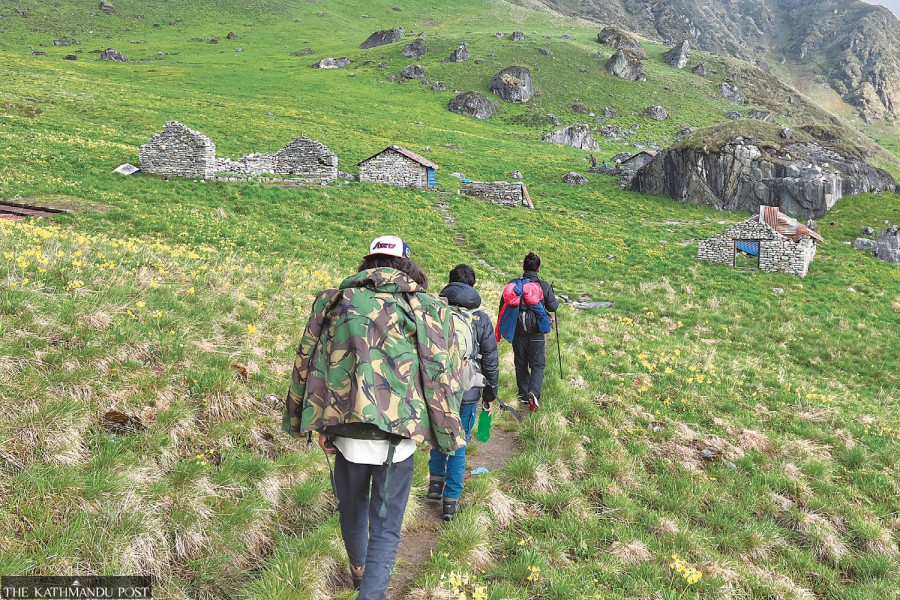Money
Trekking trails are overcrowded, but Krapu Kwholasothar is an exception
The area is located at an altitude of 3,283 metres, to the south of Annapurna and Lamjung. Trekkers can see the ruins of an over 1,500 years old village.
Deepak Pariyar
Kaski residents have started redeveloping the Krapu Kwholasothar trail, a circuit trek of religious and historical significance that remains unexplored.
Kwhlosothar, located 3,283 metres above sea level, is in the southern part of Annapurna and Lamjung. It can be reached through Tangting, Sikles, Kori and Yangjakot of Kaski and Pasgaun, Bhujung, and Ghanpokhari of Lamjung.
The shortest route is from Tangting.
Locals say it's not just an ordinary trekking trail for it connects Kwholasothar, an ancient village believed to be Nepal's first Gurung or Tamu settlement, with ruins of an ancient town over 1500-1200 years old.
Until half a decade ago, northern Kaski and Lamjung locals used this route to bring salt from Tibet.
A decade ago, a joint research team from Cambridge University of the UK and the Central Department of Geology, Tribhuvan University, studied the artefacts in Kwhlosothar.
Bed Bahadur Gurung, a Gandaki provincial assembly member and former chairman of Madi rural municipality, said the trail has many historical and archaeological sites for pilgrimages for the Tamu [Gurung] people and could be an important historical attraction for Nepali and foreign trekkers.
Kwhlosothar or Kohla Sothar is divided into three villages—lower, middle and upper.
‘Sothar’, in the Gurung language, means three villages.
Locals and researchers say Kohla Sonthar resembles the 15th-century Inca ruins of Machu Pichu in Peru. For a long time, people have been demanding the area be declared a UNESCO World Heritage Site.
“There are many historical artefacts, including houses and palaces, in these three villages,” said Gurung.
There are caves after walking two hours more from Kwhlosothar at the height 3,800. ‘The cave is known as ‘Chamsyo Nagra.’
Gurung remembers when his father brought salt via Tangting of Kwhlosothar-Namun Bhanjyang-Larke Pass-Tibet route five decades ago.
When the road from Pokhara-Butwal opened, the people of Kwhlosothar stopped going along the mountainous route.
No human settlement exists above Tangting, but many sheep and buffalo herders can be found there.
Gurung said that before the Annapurna Conservation Area Project was established in 1985, foreign trekkers used to go for camping treks. However, since the project didn’t include the Kwhlosothar, trekkers stopped hiking in the area and remained isolated.
The project promoted Manang, Lamjung, Thorong Pass, Mustanf, Myagfi and Annapurna Base Camp, Ghandruk-Ghorepani, but Kwhlosothar remained in the shadows.
In Tony Hagen's book Building Bridges to the Third World: Memories of Nepal 1950-1992, the Swiss geologist mentions his travel experience to Namun Bhanjyang, from the base of Machapuchhre to Sikles, Madi River, and Krupudanda.
The trail was named the ‘Tony Hagen Trail’ after Bed Bahadur Gurung became the chairman of the Madi rural municipality to promote it.
“This trail needs to be redefined to allow people to know the historical importance of the place. The provincial and local governments and tourism entrepreneurs of Lamjung, Manang, and Kaski all need to play an equal role in promoting the area,” said Gurung.
The Ministry of Industry, Tourism, Forest and Environment of Gandaki Province, Nepal Tourism Board office in Pokhara have been allocating a budget to promote trails in Madi in Kaski, Kwhlosothar of Lamjung and Chame of Manang. But on the promotional front, locals say nothing has been done.
The Gurung Tourism Entrepreneurs Association has named the trekking route the Gurung Heritage Trail.
“As trekking trails have been losing charm due to haphazard road construction, such trails are still untouched by modern development,” said Kisham Kumari Gurung, president of the association.
“These trails can draw high-end trekkers, which can create jobs and increase the income of people in the areas,” said the president. “Gurung heritage trail has a combination of nature and culture.”
Gurung heritage trekking trail has been developed from Tangting to Danda-Tapro-Kwhlosothar-Thulilek-Thurju-Dudh Pokhari-Gurung Deurali-Danfe Kharka-Timang to Besi Sahar, said Bobar Jung Gurung, founding president of the association.
The association's members and others recently conducted a 10-day trekking trail exploration and promotion programme.
The trekking trail includes Kwhlosothar (3,283 metres); Thulilek, a vast grazing area (4,070 metres); Dudh Pokhari, a religious place (4,585 metres); Namun Bhanjyang (5,560 metres); and Danfe Kharka, a yak grazing area (3,862 metres).
The Annapurna Conservation Area Project and the Trekking Agency Association of Nepal coordinated the exploration. The trekking can be completed in 12 days.
As a motor road has been reached to Ghandruk and Ghorepani of Annapurna Conservation Area, reducing the charm of trekking, the new trekking trail can be an alternative, said Deepak Sapkota, a member of the Trekking Agency Association of Nepal, Gandaki.
“In this area, we can revive camping trekking, which can be a big draw for trekkers.”




 5.12°C Kathmandu
5.12°C Kathmandu.jpg)















